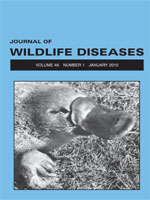Mucor amphibiorum is the only pathogen known to cause significant morbidity and mortality in the free-living platypus (Ornithorhynchus anatinus) in Tasmania. Infection has also been reported in free-ranging cane toads (Bufo marinus) and green tree frogs (Litoria caerulea) from mainland Australia but has not been confirmed in platypuses from the mainland. To date, there has been little genotyping specifically conducted on M. amphibiorum. A collection of 21 Mucor isolates representing isolates from the platypus, frogs and toads, and environmental samples were obtained for genotypic analysis. Internal transcribed spacer (ITS) region sequencing and GenBank comparison confirmed the identity of most of the isolates. Representative isolates from infected platypuses formed a clade containing the reference isolates of M. amphibiorum from the Centraal Bureau voor Schimmelcultures repository. The M. amphibiorum isolates showed a close sequence identity with Mucor indicus and consisted of two haplotypes, differentiated by single nucleotide polymorphisms within the ITS1 and ITS2 regions. With the exception of isolate 96-4049, all isolates from platypuses were in one haplotype. Multilocus fingerprinting via the use of intersimple sequence repeats polymerase chain reaction identified 19 genotypes. Two major clusters were evident: 1) M. amphibiorum and Mucor racemosus; and 2) Mucor circinelloides, Mucor ramosissimus, and Mucor fragilis. Seven M. amphibiorum isolates from platypuses were present in two subclusters, with isolate 96-4053 appearing genetically distinct from all other isolates. Isolates classified as M. circinelloides by sequence analysis formed a separate subcluster, distinct from other Mucor spp. The combination of sequencing and multilocus fingerprinting has the potential to provide the tools for rapid identification of M. amphibiorum. Data presented on the diversity of the pathogen and further work in linking genetic diversity to functional diversity will provide critical information for its management in Tasmanian river systems.
How to translate text using browser tools
1 January 2010
GENOTYPIC ANALYSIS OF MUCOR FROM THE PLATYPUS IN AUSTRALIA
J. H. Connolly,
B. J. Stodart,
G. J. Ash
ACCESS THE FULL ARTICLE

Journal of Wildlife Diseases
Vol. 46 • No. 1
January 2010
Vol. 46 • No. 1
January 2010
Intersimple sequence repeat (ISSR) analysis
ITS sequencing
Mucor
Mucor amphibiorum
mucormycosis
Ornithorhynchus anatinus
PCR




